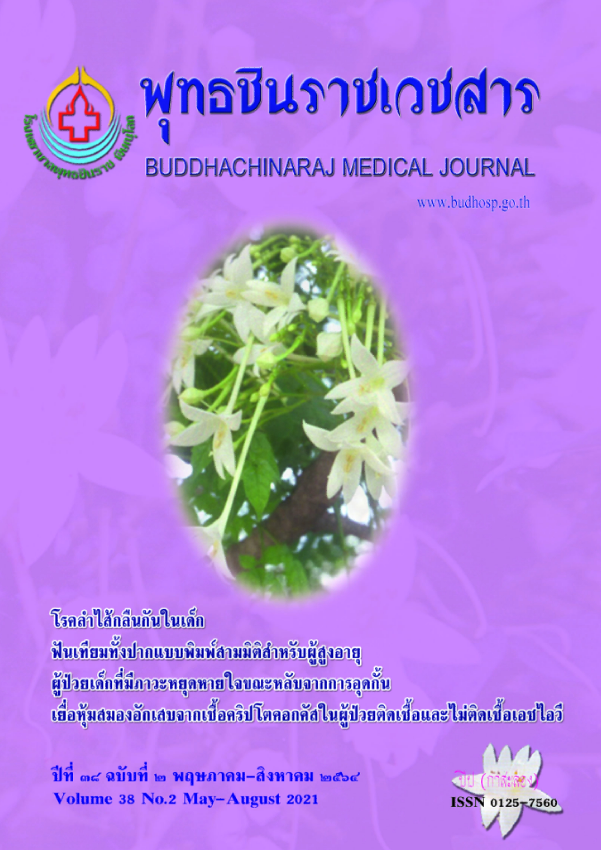แนวปฏิบัติที่อิงความเสี่ยงสำหรับ ผลการตรวจคัดกรองปากมดลูกผิดปกติและระยะก่อนมะเร็งปากมดลูก
แนวปฏิบัติที่อิงความเสี่ยงสำหรับการตรวจคัดกรองมะเร็งปากมดลูก
คำสำคัญ:
การตรวจเซลล์วิทยาที่ปากมดลูก, ระยะก่อนมะเร็ง, การดูแลผลการตรวจคัดกรองปากมดลูกผิดปกติ, แนวปฏิบัติ, มะเร็งปากมดลูกในเยี่อบุบทคัดย่อ
การตรวจคัดกรองระยะก่อนมะเร็งปากมดลูกสามารถลดอุบัติการณ์และอัตราตายจากมะเร็งปากมดลูกได้อย่างชัดเจน ความสำเร็จดังกล่าวขึ้นกับระบบการตรวจคัดกรอง หลายปีที่ผ่านมาได้กำหนดแนวปฏิบัติทางคลินิกในการดูแลสตรีที่มีผลการตรวจคัดกรองปากมดลูกผิดปกติและระยะก่อนมะเร็งปากมดลูกเพื่อพัฒนาคุณภาพการให้บริการ ในขณะที่องค์ความรู้และเทคโนโลยีได้เพิ่มขึ้นและพัฒนาอย่างรวดเร็ว การปรับปรุงแนวปฏิบัติทางคลินิกให้ทันสมัยอย่างต่อเนื่องนับเป็นเรื่องสำคัญ แนวปฏิบัติในการดูแลผลการตรวจคัดกรองปากมดลูกผิดปกติและระยะก่อนมะเร็งปากมดลูก ของ American Society for Colposcopy and Cervical Pathology (ASCCP) ได้ปรับปรุงใหม่ในปี พ.ศ. 2562 โดยยึดแนวคิดเดิมของแนวปฏิบัติเดิมปี พ.ศ. 2555 คืออิงความเสี่ยง (risk-based) แต่นำมาใช้ให้กว้างขวางและครอบคลุมมากขึ้น แนวปฏิบัติใหม่นี้เน้นการดูแลแบบครอบคลุม ในผู้ป่วยแต่ละรายตามความเสี่ยงโดยใช้ผลการตรวจในปัจจุบันร่วมกับประวัติของผลการตรวจในอดีตเพื่อประเมินความเสี่ยงในการมีหรือการเกิดมะเร็งในเยื่อบุระดับ 3 หรือที่รุนแรงกว่า (CIN 3+) ของผู้ป่วยในปัจจุบันและอนาคต บทความนี้นำเสนอการทบทวนแนวปฏิบัติและหลักฐานเชิงประจักษ์ที่เกี่ยวข้องโดยมุ่งหวังเผยแพร่ความรู้ความเข้าใจเกี่ยวกับแนวปฏิบัติใหม่ในการดูแลผลการตรวจคัดกรองปากมดลูกผิดปกติและระยะก่อนมะเร็งปากมดลูก
เอกสารอ้างอิง
2. Sung H, Ferlay J, Siegel RL, Laversanne M, Soerjomataram I, Jemal A, et al. Global Cancer Statistics 2020: GLOBOCAN estimates of incidence and mortality worldwide for 36 cancers in 185 countries. CA Cancer J Clin 2021;71(3):209-49.
3. Thanapprapasr D, Deesamer S, Sujintawong S, Udomsubpayakul U, Wilailak S. Cervical cancer screening behaviours among Thai women: results from a cross-sectional survey of 2112 healthcare providers at Ramathibodi Hospital, Thailand. Eur J Cancer Care (Engl) 2012;21(4):542-7.
4. Niu L, Virani S, Bilheem S, Sriplung H. The effect of Pap smear screening on cervical cancer stage among southern Thai women. Sci Rep 2019;9(1):16921. doi: 10.1038/s41598-019-52607-6
5. Mukem S, Meng Q, Sriplung H, Tangcharoensathien V. Low coverage and disparities of breast and cervical cancer screening in Thai women: analysis of National Representative Household Surveys. Asian Pac J Cancer Prev 2015;16(18):8541-51.
6. Perkins RB, Guido RS, Castle PE, Chelmow D, Einstein MH, Garcia F, et al. 2019 ASCCP Risk-Based Management Consensus Guidelines for abnormal cervical cancer screening tests and cancer precursors. J Low Genit Tract Dis 2020;24(2):102-31.
7. Massad LS, Einstein MH, Huh WK, Katki HA, Kinney WK, Schiffman M, et al. 2012 Updated Consensus Guidelines for the management of abnormal cervical cancer screening tests and cancer precursors. Obstet Gynecol 2013;121(4):829-46.
8. Egemen D, Cheung LC, Chen X, Demarco M, Perkins RB, Kinney W, et al. Risk Estimates Supporting the 2019 ASCCP Risk-Based Management Consensus Guidelines. J Low Genit Tract Dis 2020;24(2):132-43.
9. Fontham ETH, Wolf AMD, Church TR, Etzioni R, Flowers CR, Herzig A, et al. Cervical cancer screening for individuals at average risk: 2020 Guideline Update from the American Cancer Society. CA Cancer J Clin 2020;70(5):321-46.
10. Schiffman M, Wentzensen N, Perkins RB, Guido RS. An introduction to the 2019 ASCCP Risk-Based Management Consensus Guidelines. J Low Genit Tract Dis 2020; 24(2):87-9.
11. Cheung LC, Egemen D, Chen X, Katki HA, Demarco M, Wiser AL, et al. 2019 ASCCP Risk-Based Management Consensus Guidelines: methods for risk estimation, recommended management, and validation. J Low Genit Tract Dis 2020;24(2):90-101.
12. Castle PE, Xie X, Xue X, Poitras NE, Lorey TS, Kinney WK, et al. Impact of human papillomavirus vaccination on the clinical meaning of cervical screening results. Prev Med 2019;118:44-50.
13. Demarco M, Egemen D, Raine-Bennett TR, Cheung LC, Befano B, Poitras NE, et al. A Study of Partial Human Papillomavirus Genotyping in Support of the 2019 ASCCP Risk-Based Management Consensus Guidelines. J Low Genit Tract Dis 2020;24(2):144-7.
14. Teoh D, Musa F, Salani R, Huh W, Jimenez E. Diagnosis and management of adenocarcinoma in situ: A Society of Gynecologic Oncology Evidence-Based Review and Recommendations. Obstet Gynecol 2020;135(4):869-78.
15. Darragh TM, Colgan TJ, Cox JT, Heller DS, Henry MR, Luff RD, et al. The Lower Anogenital Squamous Terminology Standardization Project for HPV-associated lesions: background and consensus recommendations from the College of American Pathologists and the American Society for Colposcopy and Cervical Pathology. J Low Genit Tract Dis 2012;16(3):205-42.
16. Darragh TM, Colgan TJ, Thomas Cox J, Heller DS, Henry MR, Luff RD, et al. The Lower Anogenital Squamous Terminology Standardization Project for HPV-associated lesions: background and consensus recommendations from the College of American Pathologists and the American Society for Colposcopy and Cervical Pathology. Int J Gynecol Pathol 2013;32(1):76-115.
17. Khan MJ, Castle PE, Lorincz AT, Wacholder S, Sherman M, Scott DR, et al. The elevated 10-year risk of cervical precancer and cancer in women with human papillomavirus (HPV) type 16 or 18 and the possible utility of type-specific HPV testing in Clinical practice. J Natl Cancer Inst 2005;97(14):1072-9.
18. Strander B, Andersson-Ellstrom A, Milsom I, Sparen P. Long term risk of invasive cancer after treatment for cervical intraepithelial neoplasia grade 3: population based cohort study. BMJ 2007;335(7629):1077.
19. Marcus JZ, Cason P, Downs LS Jr, Einstein MH, Flowers L. The ASCCP cervical cancer screening task force endorsement and opinion on the American Cancer Society Updated Cervical Cancer Screening Guidelines. J Low Genit Tract Dis 2021;25(3):187-91.
20. Mayrand MH, Duarte-Franco E, Rodrigues I, Walter SD, Hanley J, Ferenczy A, et al. Human papillomavirus DNA versus Papanicolaou screening tests for cervical cancer. N Engl J Med 2007;357(16):1579-88.
21. Castle PE, Kinney WK, Xue X, Cheung LC, Gage JC, Zhao FH, et al. Effect of several negative rounds of human papillomavirus and cytology co-testing on safety against cervical cancer: An Observational Cohort Study. Ann Intern Med 2018;168(1):20-9.
22. Schiffman M, Kinney WK, Cheung LC, Gage JC, Fetterman B, Poitras NE, et al. Relative performance of HPV and cytology components of cotesting in cervical screening. J Natl Cancer Inst 2018;110 (5):501-8.
23. Demarco M, Cheung LC, Kinney WK, Wentzensen N, Lorey TS, Fetterman B, et al. Low risk of cervical cancer/precancer among most women under surveillance postcolposcopy. J Low Genit Tract Dis 2018;22(2):97-103.






